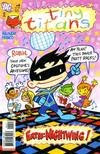 DC Comics is awash in Robins now: three characters who once held that role, one currently doing so, and a Red Robin halfway in between. But of all the Robins around, by far the cutest is the one in Tiny Titans.
DC Comics is awash in Robins now: three characters who once held that role, one currently doing so, and a Red Robin halfway in between. But of all the Robins around, by far the cutest is the one in Tiny Titans.For two years DC has published that magazine as part of its kids’ line. Its stories—comedic anecdotes and sketches, really—are “out of continuity,” and thus don’t apply to the official DC Universe, nor the DC Animated Universe(s) modeled after the company’s TV cartoons.
Tiny Titans portrays the heroes of the original Teen Titans as young kids at the Sidekick Elementary School. Their adult mentors are rarely seen grown-ups, and the next generation of teen heroes pop in as preschoolers. The magazine, created mostly by Art Baltazar, clearly owes some debt to the “Mini Marvels” back-up stories that Chris Giarrusso produced for the competition starting in 2001.
But DC Comics published a story about the Titans as toddlers even before that, in 1992’s “Teen Titans $ell-Out $pecial.” That magazine showed the superhero team raising money by licensing their likenesses for a TV cartoon, along the lines of Muppet Babies or Animaniacs. The result is Teeny Titans; all the heroes are infant versions of themselves, in a daycare run by their main villain, Deathstroke. Within the story, the team is aghast at the results and backs out of the deal.
Now, in Tiny Titans, the characters are in an elementary school, and Deathstroke is their principal. DC went back to an idea originally presented as laughably awful and did it for real. It’s a weird business.
 Tiny Titans has a large cast, but Robin is front and center, as the picture above shows. He’s appeared on eighteen of the first twenty-four covers, usually in a position of prominence. But this Robin doesn’t function like the Robin(s) in standard Titans stories.
Tiny Titans has a large cast, but Robin is front and center, as the picture above shows. He’s appeared on eighteen of the first twenty-four covers, usually in a position of prominence. But this Robin doesn’t function like the Robin(s) in standard Titans stories.As I discussed back here, on the usual Titans teams Robin is the leader, the smart one, the Badass Normal. He’s the one all the other heroes look up to, even though he has no special powers. This applies to Dick Grayson, the original Robin; to Tim Drake, the longest-running successor; and to the Robin in the animated Teen Titans.
 In contrast, the Tiny Titans Robin is the stories’ Charlie Brown figure: struggling, put-upon, worried, and not particularly talented. Issue #8 is headlined “Report Card Pickup!” and the kids are comparing grades. “I got a C!” says this Robin with a satisfied smile.
In contrast, the Tiny Titans Robin is the stories’ Charlie Brown figure: struggling, put-upon, worried, and not particularly talented. Issue #8 is headlined “Report Card Pickup!” and the kids are comparing grades. “I got a C!” says this Robin with a satisfied smile.Meanwhile, back in 1943, Batman, #18, featured the story “Robin Studies His Lessons!” in which Bruce Wayne forbids Dick from fighting crime at night until he gets his average back up to an A. It turns out Dick’s report card got mixed up with another boy’s, and he was pulling down A’s all along—of course.
In both cases, Robin is the normal kid with whom young readers are supposed to identify most closely (“Reason for Robin, #3"). But in the comedic Tiny Titans world, that identification takes the form of sympathy rather than admiration. Do little kids like that?
Well, I’m not so sure that Tiny Titans is really for little kids. A whole lot of its jokes depend on a fairly deep knowledge of the DC Universe. Take these panels from Robin’s birthday party.
 If you view that scene as a comics fanboy, you have the fun of recognizing that Robin’s friends have given him the second Nightwing costume and the outfit of the grown-up Robin of Earth Two. Subsequent panels show Robin opening other costumes from Robin history, then trying them on—a series of inside jokes. Oh, the ribaldry!
If you view that scene as a comics fanboy, you have the fun of recognizing that Robin’s friends have given him the second Nightwing costume and the outfit of the grown-up Robin of Earth Two. Subsequent panels show Robin opening other costumes from Robin history, then trying them on—a series of inside jokes. Oh, the ribaldry!Meanwhile, I can’t help imagining actual eight-year-olds looking at these panels and wondering, “Why are Robin’s friends all giving him clothes? What kind of birthday presents are those? And why is Daddy chuckling, and hogging the comic book he said was for me?”
 The costume sequence extends to this cover showing Robin in the original Nightwing costume on the light-up floor of a Saturday Night Fever disco. Which we Titans fans of thirty years’ standing can happily explain:
The costume sequence extends to this cover showing Robin in the original Nightwing costume on the light-up floor of a Saturday Night Fever disco. Which we Titans fans of thirty years’ standing can happily explain:“See, that was the costume the grown-up Robin started to wear in 1984, and it had a high collar and an open chest, so when fashions changed after a few years people started to call it ‘the disco collar costume.’ And a disco was place where people went to dance, and there was this movie called—Hey, come back inside! I’m trying to show you how to enjoy your comic book!”
At the 2010 Boston Comic-Con, I heard from Tiny Titans writer Franco Aureliani that his audience for the magazine was both little kids and fortysomething fanboys. I’m just not sure those audiences overlap.
ReplyDelete